ADHD & ODD: Confronting the Challenges of Disruptive Behavior
About half of children with ADHD also meet the diagnostic criteria for ODD but the disorders have different etiologies and respond to different types of treatment.
ABSTRACT: Disruptive behavior is the most common mental health problem seen by pediatricians. Although attention-deficit/ hyperactivity disorder (ADHD) and oppositional defiant disorder (ODD) are both considered disruptive behavior disorders-and although about half of children with ADHD also meet the diagnostic criteria for ODD-the 2 disorders are distinct, having different etiologies and responding to different types of treatment. ADHD is generally viewed as a neurobiologically mediated problem, while ODD appears to have a stronger link to environmental risk factors and psycho-social stressors. Thus, when assessing for possible ODD in a child with disruptive behavior it is important to carefully investigate any psychosocial factors that may underlie the oppositional behavior. Treatment of ADHD clearly involves medication therapy. The 2 principal types of evidence-based treatments for children with ODD are individual therapy with a focus on problem-solving and social skills and parent management training. The latter is especially important; moreover, the provision of needed external regulation of behavior in the home has substantial benefits in the treatment of both ADHD and ODD.
A significant portion of children with attention-deficit/hyperactivity disorder (ADHD) first receive the diagnosis and subsequent treatment from their primary care pediatrician. Children with ADHD who present primarily with symptoms of inattention are often managed successfully by primary care clinicians. However, ADHD is often accompanied by symptoms such as hostility, defiance, and aggression. In fact, disruptive behaviors are the most common mental health problem seen by pediatricians,1 and properly diagnosing and treating these problem behaviors is often a challenge.
In this article I address the diagnostic challenges posed by oppositional behavior in children with ADHD. I discuss approaches to evaluation and treatment that have proved particularly successful in these patients, and I provide tips on when referral may be warranted.
THE NATURE OF THE DISRUPTIVE DISORDERS
Disruptive behavior in children is not just a contemporary concern, as evidenced in this comment by Socrates: "Our youth now love luxury. They have bad manners and contempt for authority and disrespect for their elders. Children nowadays are tyrants."2 The group of disorders that are currently classified by the Diagnostic and Statistical Manual of Mental Disorders, Fourth Edition, as disruptive behavior disorders include ADHD (all 3 of its subtypes-inattentive, hyperactive-impulsive, and combined), oppositional defiant disorder (ODD), conduct disorder (CD; both of childhood and adolescent onset), and disruptive behavior disorder not otherwise specified.3 These diagnoses share primary features of poor self-regulation and associated interpersonal difficulties. Although the diagnoses share "externalizing" symptoms, there are differences in how they are conceptualized. (Externalizing symptoms are negative behaviors that a patient displays as a means of managing internal distress; examples are fighting or running away.)
ADHD is generally viewed as a neurobiologically mediated problem that requires pharmacological treatment as a primary evidence-based intervention.4 ADHD is diagnosed in 3% to 7% of school-aged children3 and when untreated can be associated with significant morbidity (delinquency, drug use, poor academic success, increase in injuries). A number of diagnoses commonly occur comorbidly with ADHD: ODD, anxiety disorders, depressive disorders, learning disorders, and substance use disorders.
While the data for the neurobiological dysfunction in persons with ADHD have mounted, with links to the monoamine neurotransmitter systems and dysfunction in the prefrontal cortex now well established, there is a dearth of data demonstrating a clear role for neurobiological dysfunction in ODD and CD. Some studies cite information on the relationship between serotonergic dysfunction and impulsivity and aggression, while others point to the existence of an abnormality of arousal in the autonomic nervous system as evidence of catecholamine dysfunction. Nonetheless, ODD and CD remain less well understood from a biological standpoint and appear to have a stronger link to environmental risk factors and psychosocial stressors.
Despite these etiological differences, ADHD often involves more than its core features of attention deficits, impulsivity, and hyperactivity. Clinicians routinely see children whose parents are challenged by their child's tantrum behaviors, poor frustration tolerance, and defiance.3 These behaviors are often best understood as resulting from biological vulnerabilities of the child that may be exacerbated by problematic family/parental responses. Understanding the relationship between oppositional and inattentive behaviors has critical importance for management decisions.
Although CD has been more systematically studied, the focus in this article will not be on children with this more serious disorder, who, by definition, intrude on the basic rights of others, break laws, and commit crimes. Instead, I have chosen to focus on ODD in order to help primary care clinicians better understand and intervene with children before severe conduct problems develop.
DIAGNOSING ODD IN CHILDREN WITH ADHD
Although some of the criteria for the diagnosis of ODD were established somewhat arbitrarily, the current ODD diagnostic criteria (Table 1) are the best method we have for identifying children who have additional difficulty with self-regulation. Between 40% and 70% of children with ADHD also meet the diagnostic criteria for ODD or CD.4-6 In a study of preschoolers with ADHD, just over 50% were found to also have a diagnosis of ODD.7 To put these figures in perspective, consider that in a group of school-aged children who may or may not have ADHD, the prevalence of ODD may be between 1% and 16%,8 or with strict application of diagnostic criteria, between 2% and 3%.9
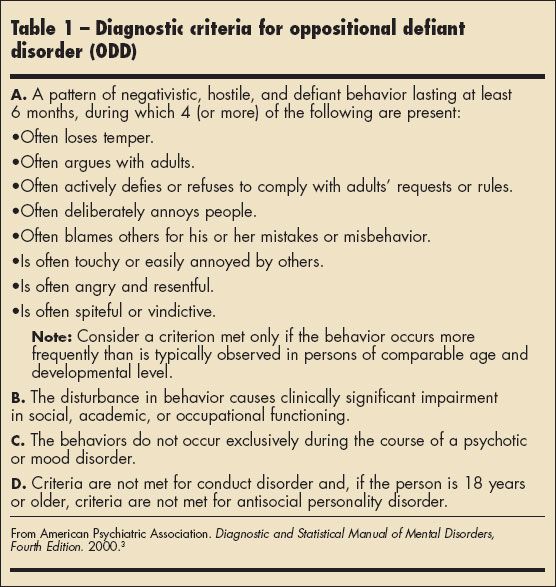
The comorbidity of ODD and ADHD seems to be bidirectional.
The clear overlap of symptoms blurs somewhat the lines of distinction between the 2 disorders and raises a number of questions for the clinician. Where does one disorder begin and the other end? Is it possible that ODD is a by-product of severe ADHD? Is there a common pathway to the evolution of disruptive behavior diagnoses? Is it possible to improve ODD symptoms simply by treating a child's ADHD?
For primary care clinicians, the importance of identifying co-occurring disorders, such as ODD and ADHD, lies in the possibility of earlier intervention, which has a greater likelihood of having an impact than does the treatment of a more enduring pathology, which may develop if intervention is not timely.
Criteria for an ODD diagnosis.
The diagnosis of ODD requires that a child display several symptoms of antagonism and hostility, have impairment in daily function, and have symptoms/behaviors in excess of what would be expected for a developmentally matched peer-all for more than 6 months.3
The symptoms should not be better accounted for by another mental illness (eg, psychotic disorder in a paranoid child who refuses to eat, or separation anxiety disorder in a child who refuses to attend school)-nor should oppositionality and defiance be symptoms of a biologically mediated illness (eg, autism, schizophrenia).10 The ODD diagnosis from a developmental perspective.
Consideration of how children acquire self-regulation in the course of normal development can help one to better understand how disruptive behavior evolves. Toddlers, in an effort to develop some independence, display expected poor self-regulation at times (hence the expression "terrible twos"). This is a normal developmental process that assists with the acquisition of new skills for self-soothing and managing unpleasant mood states. We do not consider a diagnosis of ODD in a child who is in this developmental phase. However, if, as the child ages, he or she fails to assimilate new skills and continues to have tantrums and external expressions of emotional instability, defiance, and hostility, then it is appropriate for the family to seek assistance.
RISK FACTORS FOR ODD
A multitude of factors may affect the development of certain disorders. A child may have certain vulnerabilities that contribute to the development of a disorder-or strengths that protect against it. The risk factors and protective factors associated with ODD are summarized in Table 2.

The cases featured in this article (Case 1, Case 2, Case 3) indicate different pathways to the same end: they show how different environmental factors impinging on children with individual differences all can fuel the evolution of ODD. These cases provide a springboard for a discussion of family interactional factors that may contribute to the evolution and maintenance of disruptive behavior.
TJ's mother (see Case 1), because of her own guilt about her failed marriage, had become an indulgent parent. She failed to maintain boundaries, limits, and expectations because of her discomfort "to see her child in distress." TJ's internal working model of the world was thus one that reinforced immediate gratification; his acquisition of frustration tolerance and self-soothing had been thwarted. ADHD symptoms contributed to his oppositionality and defiance, probably because he needed more structure and limits to contain his impulses.

AT's situation (see Case 2) illustrates several common reactions of parents who have exhausted their efforts to attempt to manage disruptive behavior. AT's parents were more comfortable using authoritative approaches to effect change, and once these methods failed, they were at a loss about what to do. Her father's frustration and sense of powerlessness were evidenced by his comment that "my father would have beat me if I acted this way, but we can't treat kids like that anymore." AT's parents did not err on the side of indulgence; rather, they lacked an awareness of the power of positive reinforcement and praise. Their anxiety about losing control led to their reactive, harsh parenting stance.
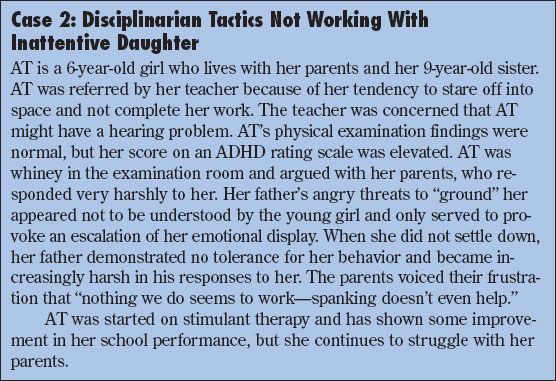
JS and his siblings (see Case 3) illustrate the challenges a chaotic home presents for the children who live there. Their mother's consultation with a psychiatrist seemed to be a turning point. When she received a diagnosis of ADHD and began treatment, her parenting improved. The home became a more predictable environment, and the increased structure was associated with calming of all the children's disruptive behavior.
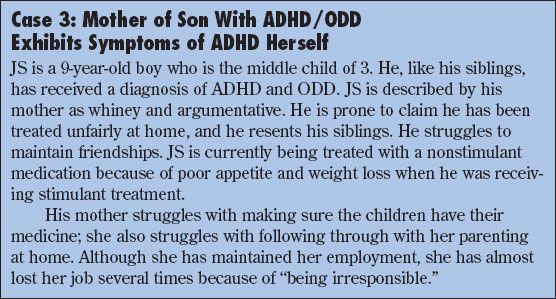
These cases suggest that children's disruptive behavior (ADHD and ODD) can arise via different pathways. However, these different paths of development share a common interactional end point: the need for familial environments that provide external regulation of behavior
EVALUATION OF A CHILD WITH DISRUPTIVE BEHAVIOR
When assessing children who exhibit negative behavior, it is important to try to understand the context of the symptoms. It would be helpful if there were a biological test or a psychological test that was reliable and valid for diagnosing any of the disruptive disorders. However, the reality is that the most important aspect of the evaluation process is the psychiatric examination. Table 3 proposes an outline for an assessment focused on understanding a child's disruptive behavior.
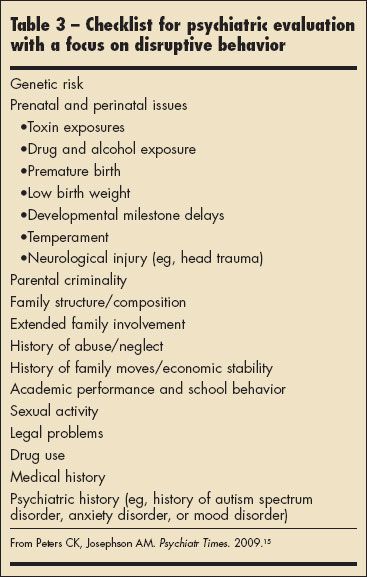
When meeting with families who are dealing with severely disruptive behavior, you may find it challenging to take the time necessary to fully understand the depth and breadth of a problem. Our health care system favors rapid assessment and quick interventions; however, at times like this, these are not what is needed. When assessing younger children, it may be prudent to meet with the parents without the child to obtain additional information. Conversely, it may be important in older children or adolescents to meet separately with them to establish rapport before meeting with their parents. After the interview process, a physical examination is indicated to rule out medical causes of disruptive behavior, however rare these may be (Table 4).

Simple assessments, such as vision and hearing tests, can sometimes obviate unnecessary interventions. In older children and adolescents, it is important to assess for substance use, as well as any severe sleep-related difficulties. Exploring the influence of language and cultural factors, when appropriate, may also lead to understandable explanations for behavioral difficulties. ADHD, ODD-or both? Because so many children and adolescents with ADHD receive a diagnosis of ODD, it can be difficult to determine how distinctly separate these 2 disorders are. Newcorn and Halperin6 discuss the challenge of differentiating ADHD from ODD and CD because of considerable symptom overlap; however, they suggest that there is evidence that ADHD and ODD/CD do not represent variations of a single entity. Still, several studies reviewed by these researchers suggest that children with ADHD are at increased risk for the development of ODD and CD. The assessment of a child with ADHD must therefore include a careful assessment of risk factors and protective factors related to ODD and CD (see Table 2). Not only does this process result in a more accurate diagnosis, it provides a starting point for interventions.
Evaluating underlying psychosocial factors.
Although biological vulnerabilities may underlie certain disruptive symptoms (eg, aggression, impulsivity), there is currently no evidence for a unifying, valid biological explanation of the origin of oppositional and defiant behaviors.11 This reality underscores the importance of a careful investigation of the psycho- social factors that underlie oppositional behavior (Table 5), as exemplified in the cases presented here.
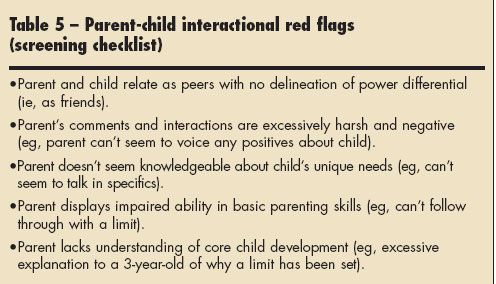
The developmental aspects of separation-individuation are often awry in patients with ODD. The 2 periods when developmentally appropriate interpersonal antagonism is most commonly seen are the toddler years and early adolescence. An assessment must thus consider the question of whether, in some patients who present with the chief complaint of oppositionality and defiance, the behavior represents normal development. The diagnosis of ODD rests on the clinician's determination of impairment and his or her own perception of how developmentally deviant the behavior has become.
To test or not to test?
Although the clinical interview is at the core of an evaluation for disruptive behavior, psychological testing is a valuable supplement that is designed to support clinical judgment.12 Psychological testing can be helpful in sorting out diagnoses.
The most commonly used psychological measures in the primary care outpatient setting are rating scales. These are filled out by older patients, patients' parents, and patients' teachers. The Conners Rating Scales and Vanderbilt Rating Scales, which are used to evaluate for ADHD, also assess oppositional and conduct-related difficulties. The scales can be scored quickly and help with sifting through the differential diagnosis.
Further assessment is typically done when requested by a clinician having difficulty in distinguishing between multiple conditions, especially if learning difficulties are involved. When making a request for psychological testing, it is important to be specific about the nature and purpose of the assessment being sought. For example, asking for help with the differential diagnosis is different from asking, "Can you assist with evaluating for the presence of a reading disorder in this child, who has ADHD, combined type?"
Helpful components of a psychological assessment of a child with a disruptive behavior disorder may include the child behavior checklist, a learning evaluation, and projective tests (eg, Rorschach test, thematic apperception test) to evaluate for sources of oppositional behavior.
TREATING ADHD WITH COMORBID ODD
After a thorough assessment establishes the presence of ODD as a comorbid diagnosis in a child with ADHD, the next questions are "what to do?"and "what to treat first?"
Treatment of ADHD.
Recommendations for the treatment of ADHD clearly involve medication treatment, usually starting with the psychostimulants.4 There are also nonstimulants that can be used, such as the FDA-approved atomoxetine, as well as off-label uses of a2-agonists (guanfacine, clonidine), tricyclic antidepressants (eg, imipramine), and bupropion.
Whatever the initial choice, there is usually appropriate apprehension on the part of parents and some physicians about using psychoactive agents in children. There has been increasing scrutiny of the true value of medication in childhood psychiatric disorders.13 However, the NIMH Multimodal Treatment Study of Children with ADHD (MTA) provided strong reinforcement of the need for medication to adequately treat ADHD.
It is with this realization that clinicians treat ADHD with medication while at the same time enlisting psychosocial therapies to address a patient's oppositional-defiant behavior. The MTA established that combining psychostimulant treatment with psychosocial interventions (ie, behavioral therapy) was helpful when treating ADHD with comorbid disorders.4 The combination of medication treatment and behavior therapy may have led to less decompensation when medication was not taken, as well as contributing to the use of lower doses of psychostimulants.14 Although oppositional and defiant behaviors may improve as a child's ADHD responds to medication, the expectation that "just"medication can be used to treat the majority of children with ADHD does not acknowledge the common co-occurrence of psychosocially mediated symptoms that require psychosocial treatments.
Treatment of comorbid ODD.
When addressing the additional concerns of disruptive behavior, it is important to look beyond medication. When ADHD and ODD co-occur in the same child, a biopsychosocial etiology is implied, necessitating a multimodal treatment approach.
The primary care pediatrician plays a critical role in the inauguration of psychotherapeutic interventions. Referring a child for psychiatric consultation and/or psychotherapy invariably taps into the family's attitudes about mental health issues. The pediatrician's attitudes and beliefs can be powerful contributors to the perception that patients and their parents have regarding mental health care.
Be especially careful not to blame the families dealing with the disruptive behaviors. Focusing on the interventions instead may improve the likelihood of their following through with a referral. To achieve this nonblaming attitude, it is helpful to keep in mind that the problematic behaviors are interactional in nature: "problematic parenting can be elicited by a 'difficult' child and, at the same time, can create problems for a child."15
Given this interactional model, it is not surprising that the 2 types of evidence-based treatments for patients with ODD are individual therapy with a cognitive behavioral focus on problem-solving skills and parental intervention in the form of parent management training (PMT).
Establishing a relationship with a child and adolescent psychiatrist can facilitate treatment planning. Such a person can direct the pediatrician to therapists who are versed in both family and individual therapies.
Parent management training.
While the chief goal in working with disruptive children is to enhance their own self-confidence in their ability to manage impulses and negative emotions, this can seldom be achieved without working with the child's family. The first step therapists typically take in working with the families of children with disruptive behavior who have been referred to them is to pursue PMT. PMT is one of the most substantiated interventions in child mental health.8,16,17 As psychopharmacological interventions are to ADHD, so PMT is to ODD. The goal of PMT is to help parents establish a more focused approach to consistency and predictability, which promotes pro- social behavior in their child. Without a positive relationship with or attachment to the child, it becomes very difficult to establish lasting change in negative behavior. PMT teaches ways to reward children (eg, surprise rewards after desired behavior, anticipated rewards). Parents learn to value praise and their relationship with their child as powerful tools for managing disruptive behavior. Finding opportunities for the parent and child to interact in healthier ways can inject much needed positive energy into a relationship that probably has been composed solely of negative interactions.
Parents are taught about limit setting, active ignoring, consequences, and communication, as well as uses of "time outs."
Webster-Stratton and Hancock state that "consistent limit setting and predictable responses from parents help give children a sense of stability and security . . . children who feel a sense of security regarding the limits of their environment have less need to constantly test it."18 It is important to remind parents that all children test parents' rules and that, by upholding the rules, parents play a significant role in helping their child develop self-regulation. Parents should be reminded that much of effective limit setting is simply a matter of acquiring and practicing skills, a process not so different from that of learning a sport or a musical instrument.
It is important to discuss with parents the need for appropriate expectations regarding the timeline of their child's response (weeks to months). Parents also need to be aware that symptoms of disruptive behavior tend to increase when the family system is changing. For example, as parents change their approach to handling inappropriate behavior, the child may become defiant to test their resolve. Preparing parents for these new stressors and helping them to view them as predictable and part of the therapeutic process is critical in maintaining their commitment to change. Some parents benefit from recommendations for adjunctive educational materials. Television shows, such as Supernanny, or parenting books, such as 1,2,3 Magic, can reinforce the skills learned in therapy.
Individual therapy for ODD. Individual work with patients with ODD is usually most effective in children of school age and older. The older the child, the more likely he will be to benefit from problem-solving skills training and social competency training. Therapy usually begins with alliance building-a challenge with children with ODD. The next step is usually to introduce a skill, to model and role-play the skill, and then to try to connect the skill to the patient's day-to-day challenges. Patients typically are given homework assignments, such as "stop, think, and act"instructions for younger children and practice in thought monitoring for older children and adolescents.19When PMT and individual therapy are not effective. Despite efforts to provide appropriate avenues of treatment for disruptive behavior, some families and children struggle to respond to PMT, social skills training, and problem-solving training. In such situations, a higher level of care is needed. Josephson and Serrano20-and other researchers21-have found that when parents do not effectively use parent management techniques, it is often because of complex individual and marital dynamics-and even diagnosable disorders. In such cases, it may be necessary for the primary care clinician to refer the family to a larger mental health system (eg, an academic center or a community mental health center).
What about using medication to treat ODD? When disruptive behavior is associated with other principal diagnoses, it is clear that medication can help.4 However, when disruptive behavior is clearly a manifestation of ODD, medication plays no role in definitive treatment. When severe and persistent ODD develops into CD, then psychopharmacological interventions to assist with severe mood dysregulation and severe aggression may be warranted, along with referrals for higher levels of care (partial programs, inpatient treatment, and residential care).
TREATMENT OUTCOMES IN 3 CASES
In Case 1, adequately treating TJ's ADHD did very little to mitigate the indulgent strategies that his mother used to assuage her own guilt and coercively minimize acute problems. She did not realize that she was impeding TJ's development of self-regulation. Through PMT and individual therapy to help her see the role her own thoughts and emotions played in maintaining her son's behavior, TJ's mother was able to make strides in creating more appropriate limits and boundaries. Although TJ continues to have challenges, he is showing progress.
In Case 2, AT's parents had been struggling with a lack of confidence in their parenting methods, and they responded well to PMT.
In Case 3, JS engaged well with the therapist and began to try out new ways of self-managing his anger and frustration. He also benefited from his mother's response to her own treatment for ADHD.
Although not every case is a success story, with better understanding of the interactional components of ODD, primary care pediatricians can provide more appropriate interventions and will be more likely to elicit the needed change. While the major goal of working with disruptive patients is to enhance their own self-confidence in managing impulses and negative emotions, this cannot occur without working with the context within which these children live-that is, their families.
References:
REFERENCES
1. Fravenglass S, Routh DK. Assessment of the disruptive behavior disorders: dimensional and categorical approaches. In: Quay HC, Hogan AE, eds. Handbook of Disruptive Behavior Disorders: Dimensional and Categorical Approaches. New York: Kluwer Academic/Plenum Publishers; 1999:49-71.
2. Finch AJ Jr, Nelson WM III, Hart KJ. Conduct disorder: description, prevalence and etiology. In: Nelson WM III, Finch AJ Jr, Hart KJ, eds. Conduct Disorders: A Practitioner’s Guide to Comparative Treatments. New York: Springer Publishing; 2006: 1-13.
3. American Psychiatric Association. Diagnostic and Statistical Manual of Mental Disorders, Fourth Edition. Arlington, VA: American Psychiatric Publishing, Inc; 2000:83-103.
4. The MTA Cooperative Group. A 14-month randomized clinical trial of treatment strategies for attention-deficit/hyperactivity disorder. Multimodal Treatment Study of Children with ADHD. Arch Gen Psychiatry. 1999;56:1073-1086.
5. Perepletchikova F, Kazdin AE. Oppositional defiant disorder and conduct disorder. In: Cheng K, Myers KM, eds. Child and Adolescent Psychiatry: The Essentials. Philadelphia: Lippincott Williams & Wilkins; 2005:73-88.
6. Newcorn JH, Halperin JM. Attention-deficit disorders with oppositionality and aggression. In: Brown TE, ed. Attention-Deficit Disorders and Comorbidities in Children, Adolescents, and Adults. Washington, DC: American Psychiatric Press, Inc; 2000:171-207.
7. Greenhill L, Kollins S, Abikoff H, et al. Efficacy and safety of immediate-release methylphenidate treatment for preschoolers with ADHD [published correction appears in J Am Acad Child Adolesc Psychiatry. 2007;46:141]. J Am Acad Child Adolesc Psychiatry. 2006;45:1284-1293.
8. Steiner H, Remsing L; Work Group on Quality Issues. Practice parameter for the assessment and treatment of children and adolescents with oppositional defiant disorder. J Am Acad Child Adolesc Psychiatry. 2007;46:126-141.
9. Angold A, Costello EJ. Toward establishing an empirical basis for the diagnosis of oppositional defiant disorder. J Am Acad Child Adolesc Psychiatry. 1996;35:1205-1212.
10. McHugh PR. Striving for coherence: psychiatry’s efforts over classifications. JAMA. 2005;293: 2526-2528.
11. Burke JD, Loeber R, Birmaher B. Oppositional defiant disorder and conduct disorder: a review of the past 10 years, part II. J Am Acad Child Adolesc Psychiatry. 2002;41:1275-1293.
12. Quinlan DM. Assessment of attention-deficit/ hyperactivity disorder and comorbidities. In: Brown TE, ed. Attention-Deficit Disorders and Comorbidities in Children, Adolescents, and Adults. Washington, DC: American Psychiatric Press, Inc; 2000:455-507.
13. Mayes R, Bagwell C, Erkulwater J. Medicating Children: ADHD and Pediatric Mental Health. Cambridge, MA: Harvard University Press; 2009.
14. Pappadopulos E, Jensen PS, Chait AR, et al. Medication adherence in the MTA: saliva methylphenidate samples versus parent report and mediating effect of concomitant behavioral treatment. J Am Acad Child Adolesc Psychiatry. 2009;48:501-510.
15. Peters CK, Josephson AM. Understanding and managing adolescent disruptive behavior: a developmental family perspective. Psychiatr Times. 2009; 26(2):42-47.
16. Kazdan AE. Parent Managed Training: Treatment for Oppositional, Aggressive, and Antisocial Behavior in Children and Adolescents. New York: Oxford University Press; 2005.
17. Mabe PA, Turner MK, Josephson AM. Parent management training. Child Adolesc Psychiatr Clin N Am. 2001;10:451-464.
18. Webster-Stratton C, Hancock L. Training for parents of young children with conduct problems: content, methods, and therapeutic processes. In: Briesmeister JM, Schaefer CE, eds. Handbook of Parent Training: Parents as Co-Therapists for Children’s Behavior Problems. 2nd ed. Hoboken, NJ: John Wiley & Sons; 1989:99-152.
19. Bloomquist ML, Schnell SV. Social competence training. In: Bloomquist ML, Schnell SV, eds. Helping Children With Aggression and Conduct Problems: Best Practices for Intervention. New York: Guilford Press; 2002:117-143.
20. Josephson AM, Serrano A. The integration of individual therapy and family therapy in the treatment of child and adolescent psychiatric disorders. Child Adolesc Psychiatr Clin N Am. 2001;10:431-450.
21. Weissman MM, Pilowsky DJ, Wickramaratne PJ, et al; STAR*D-Child Team. Remissions in maternal depression and child psychopathology: a STAR*D-child report [published correction appears in JAMA. 2006;296:1234]. JAMA. 2006;295:1389-1398.